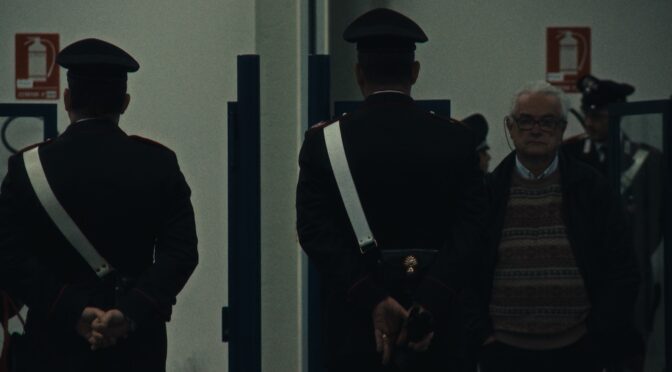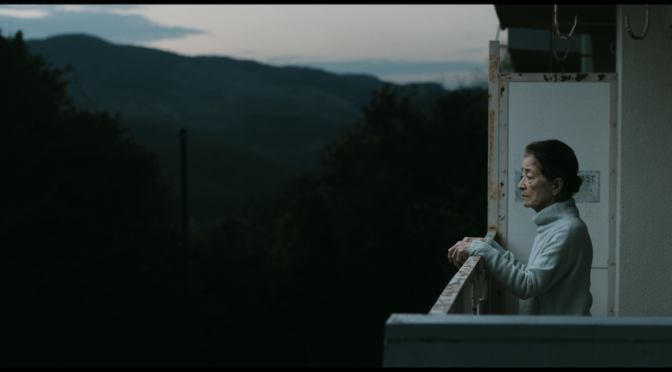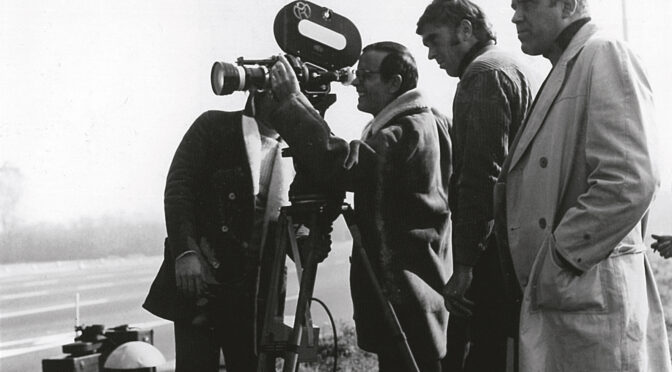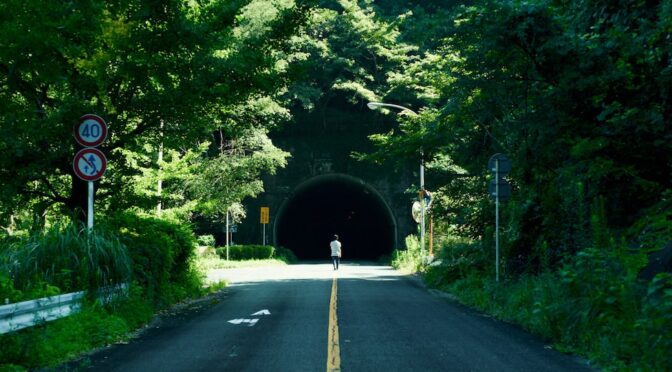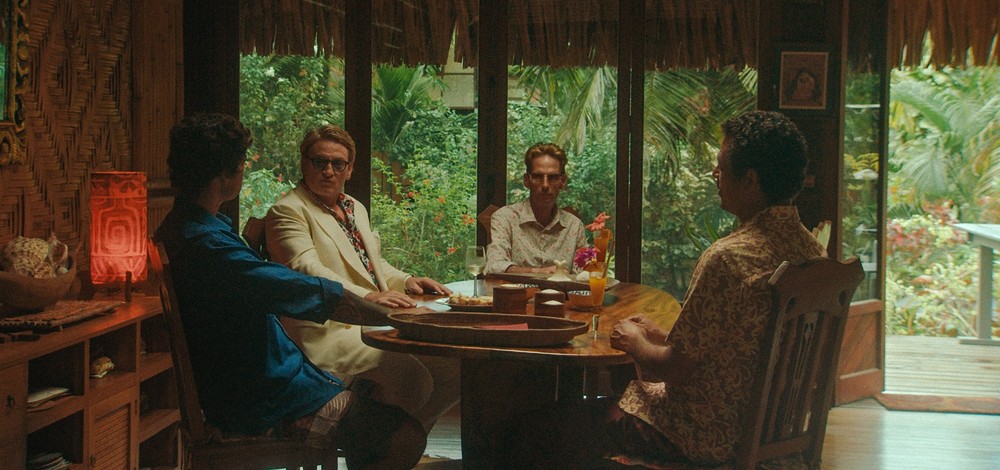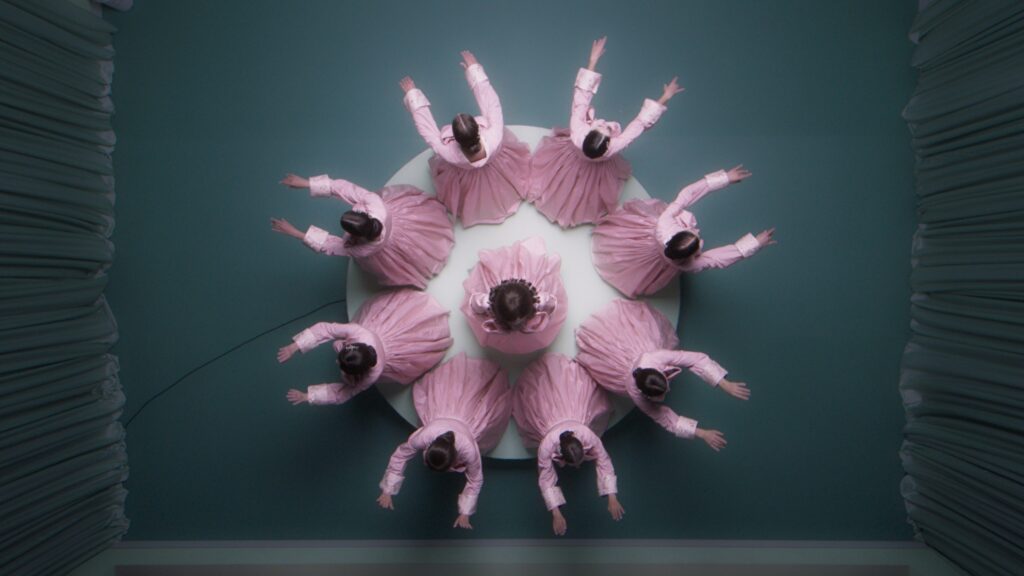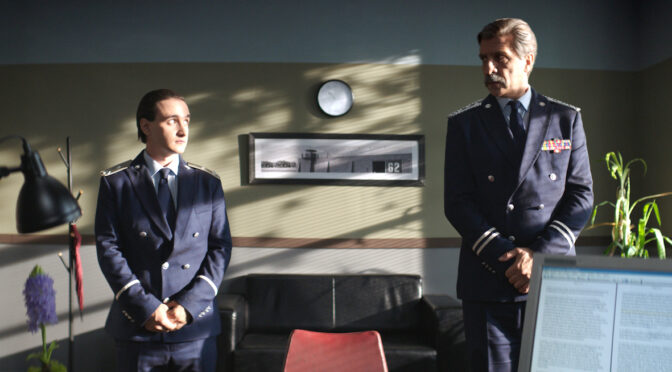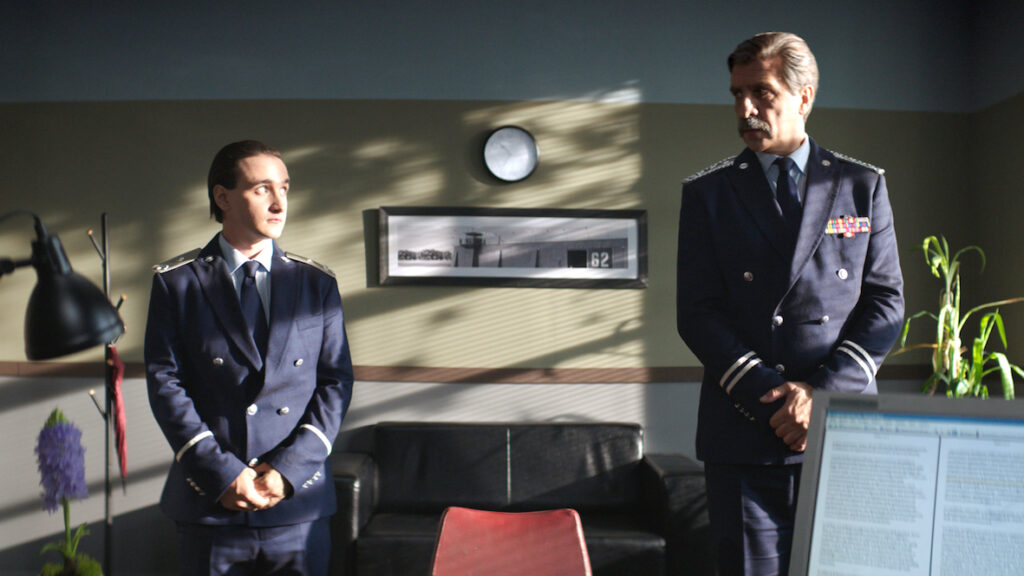Era il 27 febbraio del 2012 quando, durante lo sgombero a Chiomonte, Luca Abbà sale su un traliccio ad alta tensione: lo scopo è rallentare le operazioni di esproprio messe in atto per allargare il cantiere del tunnel, di quella “grande opera strategica” ancora oggi in sospeso. Il contatto con i cavi ad alta tensione gli causa un volo di dieci metri. Seppur incosciente, il suo corpo continua a essere percorso da scariche elettriche. Ha un polmone perforato. Entra in coma profondo.
Continua la lettura di “LA SCELTA” DI CARLO AUGUSTO BACHSCHMIDTArchivi categoria: TFF 40 – 2022
“PLAN 75” DI CHIE HAYAKAWA
Michi (Chieko Baishô) rievoca al telefono i ricordi del proprio passato: racconta la propria vita con malinconia, grata di avere qualcuno che la ascolti. Nella sua cucina non si sente altro se non la sua stessa voce. Dall’altro capo del telefono Yoko (Yumi Kawai) – molto più giovane di lei – è in silenzio. Vorrebbe concentrarsi sul racconto dell’anziana signora, ma la sua testa è altrove. A interrompere il flusso di parole di Michi è un allarme: il tempo a sua disposizione è scaduto. Yoko, trattenendo le lacrime, inizia a illustrarle cosa succederà il giorno seguente e le ripete, quasi come se fosse una supplica, che non è obbligata a farlo. Michi risponde, con tono sommesso: «Sayonara».
Continua la lettura di “PLAN 75” DI CHIE HAYAKAWA“SHE SAID” BY MARIA SCHRADER
Written by: Yulia Neproshina
Translated by: Rebecca Arturo
The unbearable weight of manipulative ambiguity, unfounded guilt, and complicit silences. Maria Schrader’s new film, out of the competition at the 40th edition of the Torino Film Festival, is a protest against Harvey Weinstein that unleashes the desire to cry out that women have been deprived of for so long, and thereby redeems the right to their voice.
Leggi tutto: “SHE SAID” BY MARIA SCHRADERA young woman at the very start of her career, her soul bursting with dreams and her eyes full of naive hope, is overcome by a request as unexpected as it is inappropriate just when she was planning to attend a business meeting. “He ripped out my voice that day, just as I was starting to find it,” discloses Laura Madden, confessing her years-long belief that she was the only one who did not have the strength to stand up to the harassment from the powerful and feared Miramax producer. Laura was far from alone, but her persecutor was for a long time protected by a well-established system that systematically and scrupulously shielded the offenders. New York Times’ reporters Megan Twohey (Carey Mulligan) and Jodi Kantor (Zoe Zakan) undertook an investigative enquiry to expose the harassment and sexual abuse committed by Weinstein, who had crossed not only professional boundaries, but also national borders, committing countless abuses overseas.

The She Said crew is well aware that they are telling a true story and do not allow room for unnecessary violence, to which women are already abundantly exposed.
Weinstein’s towering physical presence is rendered by the oral testimonies of women who describe episodes in which he holds the unmistakable authority of the perpetrator. At the same time, his voice is emblematic, as we hear it in voice over, as violent and arrogant as the suffocating agreements he induced his victims to sign, ‘legally’ depriving them of their dignity. We retrace, guided by these testimonies, the spaces from which they would have so much wanted to escape, as in a nightmare from which they were not allowed to awaken. This film, however, also wants to be a safe space for all the women involved in order to express themselves and share their grief and anger. First and foremost, Megan and Jodi, that we follow far beyond the investigative processes and that Maria Schrader reveals to us with great sensitivity and respect. The cooperation and supervision of those directly involved and their permission to enter into each other’s private lives were undoubtedly essential to achieve the goal of producing a film that resonates strongly and encourages women to trust each other.
“ORLANDO” BY DANIELE VICARI
Translated by: Bendetta Francesca De Rossi
Article by: Francesco Ghio
Having a proper compass on which one can rely can often prove to be a necessity in order not to lose one’s way too much; especially in a society which changes its skin year after year. Sometimes the right compass can be found close by, in one’s own backyard, in the apparent simplicity of a sentence spent by a person close to one’s heart; at other times, it is necessary to move away, especially if one’s loved ones, or at least those who once were, have emigrated, crossing borders, hoping for a better future. Daniele Vicari’s Compass for over ten years was Ettore Scola and Orlando, presented out of competition at the 40th Turin Film Festival, is dedicated to him.
READ MORE“ORLANDO” DI DANIELE VICARI
Avere una bussola adeguata sulla quale si possa fare affidamento, spesso, può rivelarsi una necessità per non perdere troppo la strada; soprattutto in una società che muta la propria pelle di anno in anno. A volte la giusta bussola la si può trovare accanto a sé, nel proprio giardino di casa, nell’apparente semplicità di una frase spesa da una persona vicina; altre volte occorre invece allontanarsi, soprattutto se i propri cari, o almeno quelli che un tempo lo sono stati, sono emigrati, superando i confini, sperando in un futuro migliore. La bussola di Daniele Vicari per oltre dieci anni è stato Ettore Scola e Orlando, presentato fuori concorso alla quarantesima edizione del Torino Film Festival, è dedicato a lui.
Continua la lettura di “ORLANDO” DI DANIELE VICARIBACK TO LIFE: THE RETURN OF ITALIAN POLAR
Article by: Davide Troncossi
Translated by: Maria Bellantoni
TFF40’s Back to life section dedicated to film restoration proposed a diptych of particular interest on Italian polar, restoring two of its rare gems to their original splendour. Made at a distance of time and with different characteristics, the two films are united by the cold reception they received from critics and audiences at the time of their release and then rose to cult movie status.
Read all: BACK TO LIFE: THE RETURN OF ITALIAN POLARMilano calibro 9 (1972) today represents not only the pinnacle of Fernando Di Leo’s career, but also the only Italian polar film of the period able to hold its own against the vaunted American and European crime films (between 1970 and 1972, masterpieces such as Friedkin’s The French Connection, Melville’s Le Cercle Rouge and Hodges’ Carter were released). And we would be talking about perfection if it were not for the Manichaeism of some scenes between the commissioner (Wolff) and his deputy (Pistilli) imbued with cheap socio-political rhetoric.
The restoration presented by the Centro Sperimentale di Cinematografia – Cineteca Nazionale has the great merit of restoring the overlays of the hours and days wanted by the director for the cyclical development of the plot (the title that was originally chosen was “Da lunedì a lunedì“) and of restoring the right visual and sound polish to the events of Rocco (Adorf), Nelly (Bouchet) and, above all, Ugo Piazza (a granitic Moschin), the victim, or diabolical architect, of a violent redde rationem in the organised underworld of Milan (this will become clear in the finale with a splendid triple act). The digital copy enhances the masterful direction aimed at dictating the tight rhythm (Di Leo himself, without modesty, stated “no one in Europe, apart from Melville, had the grit of an American cut that I had”) and the faithfulness of the screenplay to Scerbanenco’s anthology of hard-boiled tales from which it is based.
The picture of the acknowledged progenitor of the Italian-style detective film is completed by the neo-realist setting in which a gallery of extraordinary pulp characters act (Tarantino, by his own admission, will draw on this with full force), the pressing music by Bacalov and Osanna, and the creeping underlying determinism.

Nevertheless, one has to shift to Turin thirty years later for the other submerged and ‘cursed’ neo-noir.
Tre punto sei (2003), the debut and only feature film by the late Nicola Rondolino (son of the well-known film critic and historian Gianni), due to a series of production and distribution issues, it required a delicate recovery operation by Cinecittà, the National Cinema Museum of Turin and Augustus Color, who aimed at overcoming the obstacle of the absence of an original negative.
A versatile and much-loved figure in his hometown, who died prematurely in 2013, Rondolino immediately demonstrated an uncommon talent in his debut picture (but only few noticed it), bending genre clichés into a narrative that is not ordinary thanks to a contemporary style composed of dizzying ellipses, telluric action scenes and meaningful dramaturgical moments of clashes between the different characters. The vivid coherence of the multi-ethnic criminal imagery set in the Turin neighbourhood of San Salvario strikes a chord, avoiding the traps of the most retrograde racial prejudices, while the intense Binasco stands out in the role of the corrupt policeman madly in love with the woman contended by his best friend (a darker-than-ever Giallini), a disillusioned gangster in the service of a sui generis drug clan (an interesting experiment in quotations from The Sopranos).
The rediscovery of Tre punto sei is therefore a necessary step in the 40th anniversary of the festival that saw Rondolino as selector for a long time, regretting what he could have given to our cinema.
“MAN AND DOG” BY STEFAN COSTANTINESCU
Written by: Alessandro Pomati
Translated by: Lia Colombo
Two people are wandering in the depths of the wood; a bus drives into a tunnel whose exit cannot be seen; a thick blanket of smoke. These are just a few of the images that Stefan Costantinescu’s first feature film exploits. On one hand, the viewer can perceive the disorientation that Doru (Bogdan Dumitrache), a laborer who has emigrated to Sweden from Romania, feels upon his return. On the other, we witness his wife Nicoleta (Ofelia Popii), his teenage daughter, and his arteriosclerotic mother’s way of “welcoming” him “back” with no more than surprise and coldness; the only one to feel any genuine emotion seems to be his faithful dog Amza. Behind Doru’s unexpected return there is actually more to than the work-related reason he keeps peddling to anyone who asks: while in Sweden, Doru received anonymous messages informing him of his wife’s alleged marital infidelity. Therefore, the true purpose of his return to Romania is to verify their authenticity.
Read more: “MAN AND DOG” BY STEFAN COSTANTINESCULike many of his compatriots (Cristian Mungiu, Cristi Puiu), Costantinescu is able to create glacial and frozen atmospheres, where tensions swirl without erupting, if not at their very limit. This justifies the cold and aseptic tones of the cinematography, and the indoor shots with the clear aim of “imprisoning” the protagonists. Moreover, those scenes are built with sequence-plans in order to allow the viewer to pick every single word of what the characters say to each other. The risk of epigonism is avoided because the camera, like Doru, also breaks free from staticity and begins to peddle the characters generating a great deal of suspense, in full Hitchcockian style. While witnessing this “stalking” process, we end up putting together the pieces of the image of a country where patriarchal culture still takes hold, where the woman is not even allowed to go have a coffee without her husband’s approval, while the latter’s affairs and escapades are all but forbidden.
Through a withdrawn performance, Dumitrache is remarkably effective in capturing the grotesque dimension of the broken man. Sometimes he also manages to evoke laughter in the viewer – even in the context of domestic violence in which the film is set. Nevertheless, his partner Popii also shines with a great performance of glacial irony. However, any intended or unintended trace of humor disappears in the powerful finale: it dodges the mere consolation aim and seems to suggest that even in a society where everyone is cold, violent, distant (with or without COVID-19), mean, and obsessed with IKEA, one can always find something to hold on to. It is a struggle, but it can be done; even if you are a little bit of a man, and a little bit of a beast.
“MAN AND DOG” DI STEFAN COSTANTINESCU
Due persone che vagano nel folto di un bosco, un pullman che entra in un tunnel di cui non si riesce a vedere l’uscita, una fitta coltre di fumo: sono soltanto alcune delle immagini che Stefan Costantinescu, al suo primo lungometraggio, utilizza per descrivere la sensazione di spaesamento che Doru (Bogdan Dumitrache), operaio emigrato in Svezia dalla Romania, prova al momento del suo ritorno. Il suo arrivo suscita sorpresa, ma anche una certa freddezza nella moglie Nicoleta (Ofelia Popii), nella figlia adolescente e nella madre arteriosclerotica; l’unico a provare un minimo di genuina commozione sembra essere il suo fedele cane Amza. Dietro l’inatteso ritorno di Doru c’è in realtà di più della semplice ragione lavorativa che egli continua a propinare a chiunque glielo chieda: mentre si trovava in Svezia, infatti, Doru ha ricevuto dei messaggi anonimi che lo informavano della presunta infedeltà coniugale di sua moglie. Lo scopo del suo ritorno in Romania è appurarne la veridicità.
Leggi tutto: “MAN AND DOG” DI STEFAN COSTANTINESCUCome molti suoi connazionali (Cristian Mungiu, Cristi Puiu), Costantinescu dà prova di riuscire a creare atmosfere glaciali e sospese, dove le tensioni serpeggiano senza scoppiare se non al limite estremo. Questo giustifica la fotografia dai toni freddi e asettici, le riprese realizzate per lo più in interni con lo scopo di “imprigionare” i protagonisti e, in questi interni, i piani-sequenza volti a non perdere neanche una parola di quello che essi si dicono. Il rischio di epigonismo viene evitato nel momento in cui anche la macchina da presa, al pari di Doru, si libera dalla staticità e comincia a pedinare i personaggi in scene di altissima suspense, in perfetto stile hitchcockiano. A emergere da questo “pedinamento” è l’immagine di un Paese in cui la cultura patriarcale la fa ancora da padrone, dove alla donna non è concesso di prendere neanche un caffè senza l’approvazione del marito, mentre a quest’ultimo le scappatelle e le sregolatezze sono tutt’altro che proibite.
Dumitrache, attraverso uno stile recitativo spesso in sottrazione, è straordinariamente efficace nel catturare la dimensione grottesca del maschio in crisi, riuscendo spesso a suscitare il riso nello spettatore – pur nel contesto di violenza domestica in cui il film si ambienta. D’altro canto, la sua partner, Popii, brilla in un’interpretazione di glaciale ironia. Ma ogni traccia di umorismo, voluto o involontario, sparisce nel potente finale, che sembra suggerire (schivando il proiettile della consolazione) che persino in una società così fredda, violenta, distante (con o senza COVID-19 a tenerci separati), meschina, con l’ossessione di vivere in “stile IKEA”, si può trovare qualcosa a cui aggrapparsi. È una fatica, ma si può fare; anche se si è un po’ uomini, e un po’ bestie.
Alessandro Pomati
“NAGISA” DI KOGAHARA TAKESHI
Nagisa, lungometraggio d’esordio del regista giapponese Kogahara Takeshi, può essere interpretato come un complesso e stratificato tentativo di rielaborare un legame, di ridefinire quel sottile filamento che collega il corpo di chi sopravvive e il ricordo, sempre più evanescente, di chi non c’è più. Il mondo che viene rappresentato è dunque frutto di un’offuscata condizione mentale, un insieme di indistinte rievocazioni partorite dalla mente di un ragazzo distaccato dalla realtà.
Leggi tutto: “NAGISA” DI KOGAHARA TAKESHIIl protagonista è Fuminao, un ragazzo di Tokyo tormentato dal senso di colpa per la morte della sorella minore Nagisa, deceduta tre anni prima in un incidente stradale mentre andava a trovare il fratello in autobus. Una notte il ragazzo accompagna l’amico Yuki a visitare un tunnel che, secondo alcune credenze popolari, pare essere infestato dai fantasmi. In questo misterioso e tetro luogo si troverà ad affrontare nuovamente il suo passato, le sue origini, fino a rivivere nella propria mente l’intenso rapporto con la sorella scomparsa. Il film è in fondo la riproposizione di un cortometraggio omonimo realizzato dallo stesso Kogahara nel 2017, in cui i due protagonisti, sempre Fuminao e Nagisa, sono però due giovani innamorati. Alla “love story” adolescenziale del primo si contrappone quindi, in questa seconda opera, il ricordo di un defunto e il richiamo al flebile sospiro della morte, in una folle danza che coinvolge Eros e Thanatos fino a renderli parte di uno stesso essere.
L’apatia del protagonista, così come l’alienazione che ne condiziona l’esistenza, nascono dal forte trauma scaturito dalla perdita di una persona amata. Per questo motivo la vita del giovane è costantemente scandita da movimenti meccanici e continui silenzi, raffigurati attraverso l’utilizzo di reiterate e interminabili inquadrature fisse. La storia è frammentata, per nulla lineare, come se ogni brandello di memoria riaffiorasse spontaneamente quando Fuminao assapora determinate sensazioni fisiche o emotive. Questo rende il film un vero e proprio labirinto senza vie d’uscita, un rompicapo in cui, talvolta, risulta difficile comprendere il senso di alcuni avvenimenti.

Al termine di questo enigmatico viaggio esistenziale sono molte le domande che sorgono, suscitando nella mente del protagonista più dubbi che risposte. «I fantasmi esistono davvero?» chiede esitante il ragazzo a un poliziotto incontrato casualmente fuori dal tunnel. La risposta dell’uomo arriverà solo dopo un lungo e ostentato silenzio: «Il fantasma sei tu». Sono coloro che sono rimasti ancorati al passato, incapaci di proseguire una vita normale, come una donna che vaga per strada alla ricerca del figlio scomparso, a rappresentare i veri spettri della società.
Emidio Sciamanna
“WAR PONY” DI RILEY KEOUGH E GINA GAMMELL
Presentato in concorso alla quarantesima edizione del Torino Film Festival, già vincitore della Camera d’Or a Cannes, dove concorreva nella sezione Un Certain Regard, War Pony segna l’esordio alla regia dell’attrice Riley Keough e della produttrice Gina Gammell, con un appassionante ritratto della comunità di nativi americani coinvolta direttamente nella realizzazione del film.
Continua la lettura di “WAR PONY” DI RILEY KEOUGH E GINA GAMMELL“UNREST” BY CYRIL SCHÄUBLIN
Article by: Sara Longo
Translated by: Rachele Pollastrini
“After spending a few weeks with the watchmakers, my views on socialism were resolved: I was an anarchist.” With this sentence by Pyotr Kropotkin extracted from his Memoirs of a Revolutionary (1877), director Cyril Schäublin decided to start his second feature film ‘Unrest’ in which, by reconstructing the events of 1870, he recounts how the independence of thought of the artisans in the Jura Mountains ignited the spark for the birth of the international anarchist movement.
Continua la lettura di “UNREST” BY CYRIL SCHÄUBLIN“PACIFICTION” BY ALBERT SERRA
Article by: Irma Benedetto
Translated by: Alice Bettinelli
When approaching the work of Albert Serra, we cannot help but notice the great contradiction at the heart of his cinema: that between the setting of his images, which nestle in the past of the European history (from the 1980s of his debut film to the 1700s French – his favourite historical period – of La mort de Louis XIV and Liberté) and the sense of atrophy, of an absolute and out-of-time present that apocalyptically pervades his characters, always waiting for a climax that will never come, or that perhaps has already arrived.
Read more: “PACIFICTION” BY ALBERT SERRAA spasmodic wait for the end that becomes nuclear paranoia for a Benoît Magimel called to play the ambiguous protagonist of Pacifiction, a diplomatic commissioner who has arrived in the former French colony of Tahiti to try to investigate unsettling rumours of an imminent resumption of dangerous atomic tests. Serra works on the extreme stylisation and opacity of the characters and on the exhibited artificiality of lights – as was already the case in the unforgettable finale of Liberté – to create a highly suggestive visual texture, a floating and uncertain space in which it is possible to perceive the abstraction of power in all its ruthless and pervasive senselessness. It is between half-voices and hints that the protagonist De Roller – designated intermediary between the politicians and the population – probes the island moving as if in a limbo – a somnambulist wandering in what seems to be an only-apparent state of life. The viewer is restrained in the hypnotic movement of the film, which concedes few clues and casts wide, unresolved grey areas, constantly moving to an unknowable off-screen that weights like an omen.
To duplicate and amplify the feeling of threat that travels under the skin, there is the eerie presence of the ocean, which with its surface engulfs and conceals. De Roller is driven by a desire for clarity that will never become tangible reality. In the most important dialogue-monologue of the film, the protagonist talks about a world that has lost the conception of time and memory, of a humanity that must have as its primary need that to illuminate, to see the withered skins of power that have already been embodied by the exposed and dying body of Jean-Pierre Léaud in La mort de Louis XIV. With Pacifiction, Serra continues his work on the perception of the present and the invisible decomposition of a frozen and motionless time, aiming his gaze for the first time at contemporaneity.
“PACIFICTION” DI ALBERT SERRA
Quando ci si accosta all’opera di Albert Serra non si può fare a meno di notare la grande contraddizione che sta alla base del suo cinema: quella fra l’ambientazione delle sue immagini, che si annidano nel passato della storia europea (dagli anni ’80 del film d’esordio al 1700 francese – periodo storico da lui prediletto – di La mort de Louis XIV e di Liberté) e il senso di atrofizzazione, di presente assoluto e fuori dal tempo che pervade in maniera apocalittica i suoi personaggi, sempre in attesa di un climax che non arriverà mai, o che forse è già arrivato.
Leggi tutto: “PACIFICTION” DI ALBERT SERRAUn’attesa spasmodica della fine che diventa paranoia nucleare per un Benoît Magimel chiamato a interpretare l’ambiguo protagonista di Pacifiction, un commissario diplomatico arrivato nell’ex colonia francese di Tahiti per cercare di indagare su inquietanti voci che vogliono un’imminente ripresa di pericolosi test atomici. Serra lavora sull’estrema stilizzazione e opacità dei personaggi e sull’artificialità esibita delle luci (come già avveniva nell’indimenticabile finale di Liberté) per creare una tramatura visiva di grande suggestione, uno spazio flottante e incerto in cui si riesce a percepire l’astrazione del potere in tutta la sua spietata e pervasiva insensatezza. È fra mezze voci e accenni che il protagonista De Roller, tramite designato fra i politici e la popolazione, sonda l’isola muovendosi come in un limbo: un sonnambulo che vaga in quello che sembra uno stato di vita solo apparente. Lo spettatore viene imbrigliato nel movimento ipnotico del film, che concede pochi indizi e lancia ampie zone d’ombra irrisolte, rimandando costantemente ad un fuori campo inconoscibile che grava come un presagio.
A duplicare ed amplificare la sensazione di minaccia che viaggia sottopelle è la presenza inquietante dell’oceano, che con la sua superficie inghiotte e nasconde alla vista. De Roller è guidato da una volontà di chiarezza che non si concretizzerà mai: nel dialogo-monologo più importante del film il protagonista parla di un mondo che ha perso la concezione del tempo e della memoria, di un’umanità che deve avere come necessità primaria quella di illuminare, di vedere le pelli avvizzite del potere che sono già state incarnate dal corpo esposto e morente di Jean-Pierre Léaud in La mort de Louis XIV. Serra continua con Pacifiction il suo lavoro sulla percezione del presente e sulla decomposizione invisibile di un tempo raggelato e immobile, puntando il suo sguardo per la prima volta sulla contemporaneità.
Irma Benedetto
“CHIUSURA” DI ALESSANDRO ROSSETTO
Rivedere a ventuno anni dalla sua uscita Chiusura di Alessandro Rossetto rende ancora più ardua l’analisi del film. Vedere un mondo che non c’è più, percepire la consapevolezza che esso stesso aveva di essere giunto a una fase terminale, la fine di un millennio e tutte le paure a esso annesse, genera nello spettatore un misto di ansia e tenerezza. C’è l’amore per un passato che sta svanendo ma, allo stesso tempo, la consapevolezza che non molto è cambiato. La provincia rimane a distanza di anni un luogo paludoso, stagnante, a cui è difficile fuggire ma che attraverso l’immagine cinematografica ha un richiamo romantico e affascinante. È proprio la capacità di mostrare questa doppia anima della provincia e questo scarto tra tradizione che svanisce e modernità che avanza a rendere grande il cinema di Alessandro Rossetto. Chiusura, come detto dallo stesso regista, è un film che a distanza di anni è diventato una riflessione sul tempo che passa.
Leggi tutto: “CHIUSURA” DI ALESSANDRO ROSSETTOIl documentario, restaurato sotto la supervisione di Rossetto stesso dall’Istituto Luce, segue la chiusura del negozio di parrucchiera della signora Flavia dopo 44 anni di attività. Il regista, laureato in antropologia, osserva attentamente i piccoli gesti di questo mondo, le parole degli abitanti che lo abitano, i conflitti che lo animano. A questo mondo se ne affiancano altri: il circo che arriva in città e la squadra di calcio femminile locale. L’osservazione di questi mondi si concentra allo stesso modo sugli impercettibili riti e conflitti, sulle emozioni personali delle persone che li abitano.
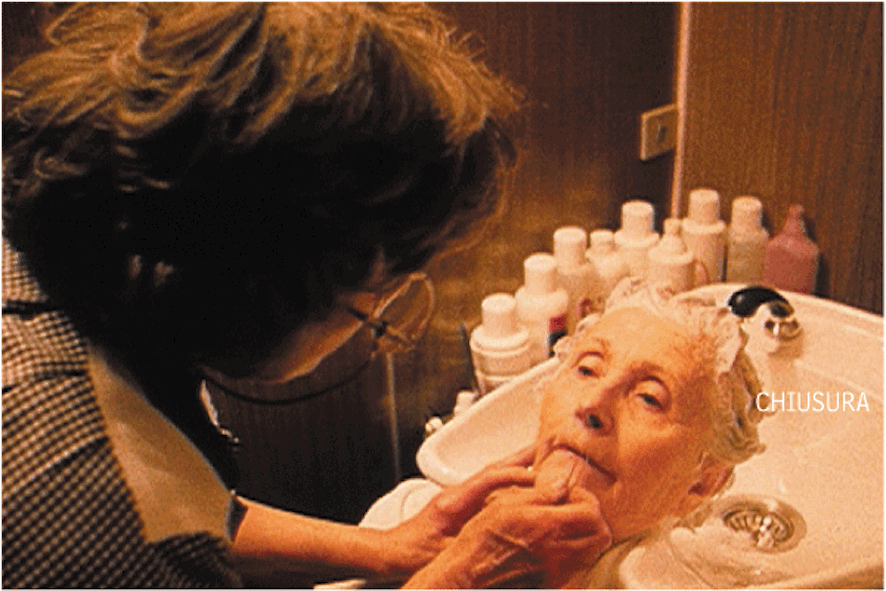
Ad aleggiare su questo microcosmo è però la nebbia invernale, elemento costante del film, che amplifica la sensazione di staticità e pure di fine, di chiusura di un periodo giunto ormai al suo termine. A spiccare però è la bellezza di questi elementi e la capacità del cinema del reale di dare fascino alle cose della vita comune. La sensazione di paralisi trascende e diventa bellezza: i gesti, le parole e i discorsi personali divengono ammalianti e affascinanti agli occhi dello spettatore.
Il tempo trascorso amplifica quindi l’esperienza di visione di Chiusura, a cui la riflessione sul tempo e la fine di un’era si aggiunge la riflessione a posteriori su un periodo che ormai è trascorso, ma le cui emozioni e sensazioni rimangono ancora incredibilmente vivide.
Cristian Cerutti
“LA PIEDAD” BY EDUARDO CASANOVA
Article by: Romeo Gjokaj
Translated by: Rita Brigante
When Mateo (Manel Llunell) is diagnosed with brain cancer, his mother Libertad (Ángela Molina) gets the chance she was looking for: Mateo is now harmless, in need of care and attention that only she can give him. Eduardo Casanova proposes an Oedipal love story with his second full-length-film “La piedad”, presented in competition at the 40th edition of Torino Film Festival.
Read more: “LA PIEDAD” BY EDUARDO CASANOVAMateo never leaves home without his mother, they sleep together in the same bed, and whenever one of them gets sick, both of them experience symptoms. Their personalities are blended to the point that they sometimes get swapped or one merges with the other; they laugh, cry, and suffer together. Mateo was born to satisfy his mother’s need to be essential for someone. What scares Libertad is the prospect that one day her son will grow up and be independent, take a bath on his own, and leave home. She wants him to stay in their little bubble in which she breastfeeds him and nurtures him forever, even though he is a grown man. The relationship between mother and son is compared with the parallel story set in North Korea, where dictator and subject cannot live without each other. Firstly, Mateo’s absent father plays the tyrant’s role, as he appears in Mateo’s dreams in the place of di Kim Jong-un while killing a unicorn, but the son will soon realize that the real cause of his discomfort his is mother.
As it is true with his first work, Skins (2017), Casanova is not scared of showing images that bring cinema back to pure visual art, building a voyeuristic relationship among the viewers that ask themselves whether they want to keep looking at the screen or not. The colour pink dominates the scene, exposing and dissecting the characters’ unspeakable secrets. They lose their humanity and become torn, sick pieces of flesh. The director is much interested in psychic anomalies rather than physical ones. Therefore, Casanova investigates the result of the combination of two psychic disorders: firstly, the Münchausen syndrome by proxy is the syndrome which leads Libertad to keep her son in a sickly stage by secretly drugging him, and secondly, the Stockholm syndrome that leads Mateo back to his tormentor, his mother. The son’s Oedipus complex, which makes him hate his father (whom he replaces) without even knowing him, contributes to the couple’s toxicity. Moreover, even though his mother is the cause of all his misfortunes, Mateo cannot survive without her, since he does not conceive anything except the morbid love that has accompanied him from birth.
“LA PIEDAD” DI EDUARDO CASANOVA
Quando a Mateo (Manel Llunell) viene diagnosticato un cancro al cervello, la madre Libertad (Ángela Molina) ha l’occasione che cercava: Mateo è ora totalmente indifeso, bisognoso di cure e attenzioni che solo lei è in grado di fornirgli. È una storia di amore edipico quella che Eduardo Casanova ci propone nel suo secondo lungometraggio La piedad, presentato in concorso alla quarantesima edizione del Torino Film Festival.
Leggi tutto: “LA PIEDAD” DI EDUARDO CASANOVAMateo non esce mai di casa senza la madre, dormono insieme nello stesso letto e quando uno dei due si ammala anche l’altro avverte i sintomi. Le personalità dei due sono talmente amalgamate da arrivare a scambiarsi e fondersi, ridendo, piangendo e soffrendo insieme. Mateo è nato proprio per soddisfare il bisogno della madre di essere indispensabile per qualcuno. La prospettiva che un giorno Mateo cresca e diventi indipendente, si faccia il bagno da solo e esca di casa per conto suo, spaventa la madre che cerca di tenerlo in una bolla in cui resti per sempre il suo bambino, da allattare a accudire, anche ora che è ormai cresciuto. Il rapporto tra madre e figlio dialoga con la vicenda parallela ambientata in Corea del Nord, nella quale dittatore e suddito non possono fare l’uno a meno dell’altro. Se all’inizio per Mateo è il padre assente a ricoprire il ruolo di tiranno e ad apparirgli in sogno nelle veci di Kim Jong-un intento ad uccidere un unicorno, presto si renderà conto che è invece la madre la causa del suo malessere.
Così come nella sua opera prima, Pelle (2017), Casanova non ha paura di mostrare immagini attraverso cui il cinema ritorna pura arte visiva, creando un legame voyeuristico con lo spettatore che si chiede se continuare a guardare o distogliere lo sguardo. Il colore rosa domina la scena mettendo a nudo e sviscerando i segreti inconfessabili dei personaggi, che perdono la propria umanità per diventare semplici pezzi di carne lacerati e malati. Ma più delle anomalie corporee, sono quelle psichiche ad interessare il regista. Casanova infatti indaga il risultato della combinazione di due disturbi psichiatrici quali la sindrome di Münchausen per procura, che porta la madre a tenere il figlio in stato di malattia somministrandogli farmaci di nascosto, e la sindrome di Stoccolma, che induce il figlio a tornare dalla madre-aguzzina. Il complesso edipico del figlio, che odia il padre senza averlo mai conosciuto e al quale si sostituisce, contribuisce poi alla nocività della coppia. Così, nonostante la madre sia la causa di tutti i suoi mali, Mateo non può fare a meno di lei, perché non concepisce nulla di diverso da quell’amore morboso che lo ha accompagnato dalla nascita.
Romeo Gjokaj
“THE PLAINS” BY DAVID EASTEAL
Article by: Enrico Nicolosi
Translated by: Giuliano Gisotti
The Plains, David Easteal’s first feature film, is the Australian filmmaker’s experimental attempt to faithfully reconstruct his time spent in the car of Andrew Rakowski, a lawyer in his 50s returning home at the end of his workday in Melbourne’s outer suburbs. A work that eludes definition, a radical, yet malleable cinema verité.
Continua la lettura di “THE PLAINS” BY DAVID EASTEAL“LA LUNGA CORSA” BY ANDREA MAGNANI
Article by: Romeo Gjokaj
Translated by: Niccolò Sereno
The oyster that remains attached to the rock on which it was birthed by fate will live peacefully. The oyster that instead ventures into the unknown in search of fortune can only end up swallowed by the ocean. This is the so-called “Ideal of the Oyster”, which is essential in the events of “I Malavoglia” by Giovanni Verga and of “La Lunga Corsa”, the second movie by director Andrea Magnani and the only Italian feature film in competition at the fortieth edition of the Turin Film Festival.
Leggi tutto: “LA LUNGA CORSA” BY ANDREA MAGNANIGiacinto (Adriano Tardiolo) was born and raised in prison, the only environment he recognizes as home during his training process. Abandoned by his parents, he is looked after by prison guard Jack (Giovanni Calcagno), who becomes his figure of reference. However, Jack would like Giacinto to go out and make a living away from the bars and narrow corridors through which the boy enjoys running despite it being forbidden. Thus, he takes him to a family house which, however, is more of a prison for the child than the prison itself. As soon as he gets the chance, he runs away and attacks a man to get arrested and be able to go “home”, but he discovers that children cannot go to prison. So, he tries again on his eighteenth birthday. Jack understands that Giacinto will never change his mind and has him hired as a guard in the penitentiary, which thus becomes a place of work, lodging and recreation for him.
If “Easy – Un viaggio facile facile” (2017), Magnani’s first work, was a classic road movie, here instead a static journey is presented: Giacinto runs for hours but never moves, he remains inside his miniature “Matrix”, preferring the blue pill to the red one (colors that, among other things, are recurrent in the film). He wants to stay locked up in his cave because he sees nothing interesting in the frenetic stillness that pervades the exterior, where people seem to do nothing but run aimlessly between circling buses and construction sites that have been standing still for years.
Jack tries to get Giacinto to escape from what he sees as a mental cage without realizing that he himself is the first of the prisoners chained to a life that doesn’t satisfy him and from which he tries to escape by drinking in the evening. Giacinto doesn’t run to escape or to win a race; he runs to run, unlike those like Jack who would like to flee, but stand still in their perpetual unhappiness.
“IL CORPO DEI GIORNI” BY SANTABELVA
Artcle by: Nicolò Pilon
Translated by: Rachele Pollastrini
Thanks to the Covid-19 emergency a lifer finds himself in a situation of greater freedom when compared to that experienced by many others. In Il corpo dei giorni much more is revealed, thanks to this paradox. Santabelva collective meets the lifer Mario Tuti, one of the protagonists of the neo-fascist terrorism in the 1970s, in an unexpected situation. Interesting starting points arise from this confrontation, both historically and cinematically.
Continua la lettura di “IL CORPO DEI GIORNI” BY SANTABELVA“VIENS JE T’EMMÈNE” BY ALAIN GUIRAUDIE
Article by: Federico Lionetti
Translated by: Anna Polimeni
In the theory of pre-established social relations, the practice of affection allows one to unhinge the certainties on which one individual bases his or her relationship with the other. Life is a tumult of unexpected encounters, of ephemeral and transitory desires, of painful external interferences and accidental impediments: men must get used to the mutability of life, making themselves and their desires as inconstant as the unpredictable circumstances of reality.
Continua la lettura di “VIENS JE T’EMMÈNE” BY ALAIN GUIRAUDIE
